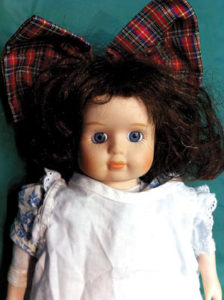
Mary Anne sent me photographs of a collection of dolls she wants to sell. She packaged them up in original boxes. The dolls are part of the “Victorian Collection” by Melissa Jane, a company which made its dolls in China in the 1970’s and 80’s.
They all have a distinctive face, but like all dolls, the faces scare me. To tell the truth I have pediophobia, a fear of dolls! Pediophobia is one of the more common kinds of phobias. This is related to coulrophobia, a fear of clowns. But before you think me certifiable, I noticed a new phobia entered the dictionary. Monophobia – fear of being out of mobile phone contact, which I suspect many people suffer from. A phobia exists for everyone. Mine encompasses a severe dislike of dolls. And Murphy’s Law says, Elizabeth gets at least one call a day asking her to appraise dolls.
Now back to Mary Anne’s dolls.
In the 1970’s and 80’s, for some reason, many women ordered mass production dolls with which, the misguided believed, eventually created a valuable collection. Advertisers possibly guaranteed collectibility, even used the word “collectible” in the doll’s name. For example the “Collectible Barbie.” Really the only collectible dolls are the unique dolls, those that are rare because they’re old or antique, or rare because they’re works of art, a kind of artiste creation. Dolls made to look Victorian yet made in the 1970’s and 80’s are possibly the least valuable dolls you can inherit. And many people call me with just that question. “What do I do with the 2,000 factory made dolls produced about 20 years ago that Mom collected?”
No real market exists for these dolls.
“Victorian Collection” dolls abound on eBay. The “buy it now” price hovers around $20 for each doll. And everyone knows the “buy it now” price is often unrealized.
Doll Collecting, says the United Federation of Doll Clubs, Inc. (a nonprofit organization for the promulgation of doll collecting) remains in the top arena of collecting, second only to stamp collecting, worldwide. Another national organization of doll collectors, the Original Doll Artists Council of America, furthers the promotion of original doll art. To understand the difference between original dolls and factory made dolls, I turned to The Susan Quinlan Doll & Teddy Bear Museum and Library. This museum houses thousands of dolls, which scare me, but may interest the mentally healthy. Not only a museum, Ms Quinlan’s Museum has around 10,000 volumes pertaining to dolls and Teddy bears. On the matter of what is an original artist-created doll, the Quinlan website considers it more like figural sculpture.
Two Types of Doll Collecting
I learned from the Quinlan Museum’s website that the Quinlan’s, husband and wife, Terry and Susan, conducted a survey polling 10,000 doll and Teddy collectors in the U. S. An interesting psychological picture emerges (remember I am phobic) from what they found regarding the motivation to collect.
The first of the two types of doll collectors, those who feels nostalgic – which I most definitely am not – adult collectors drawn to the dolls popular in childhood. Some of the questions I myself field from clients who inherited dolls fall into three age related categories:
- when mom is over 60-70 years I hear: “I inherited a collection of composition dolls: Shirley Temples, Madame Alexanders, and Nancy Ann Storybook dolls. What do I do with them?”
- when Mom is 40-50 years, I hear: “I inherited 1950’s and 60’s hard plastic or vinyl dolls such as Saucy Walkers, Ginnys, Alexanderkins, Chatty Cathies, Miss Revlons, Barbies, Liddle Kiddles, and Tammies. What do I do with them?”
So here I see proof that certain collectors feel nostalgic for what they remembered of their youth, as women in those age groups played with the dolls mentioned above.
The Quinlan’s Survey
But the Quinlan’s survey indicated that collectors who collect original dolls and Teddy artist’s pieces are not necessarily reaching back to a happy childhood of playing with certain dolls. The Quinlan site says, “Based on our collector survey the original interest in collecting artist and antique pieces did not stem from play with dolls and bears. But from other experiences later in life. Many stated collecting them in their 30’s.” It seems in collecting some kinds of dolls, collectors are not necessarily seeking to revert to childhood. Some collect hand-made works of art, or very rare older antique girl and boy dolls. Visit their museum right here in Santa Barbara to see some examples.
So the bad news, Mary Anne, is you really won’t profit from your inheritance of those “Victorian Collection” dolls. In fact in collecting dolls price appreciation is never guaranteed in collecting any category of dolls. Take, for example, the Modern “Barbie Collectible Dolls,” from the mid 1990’s, which have crashed. Another example is the Madame Alexander dolls from the 1970’s and 80’s, which have today sunk to less than half their original cost. The idea in doll collecting dolls remains to collect because you like to collect, and forget about leaving your kids a legacy. This is an area of material culture that I myself will never collect. Nothing scares me more than a doll’s face in the night.